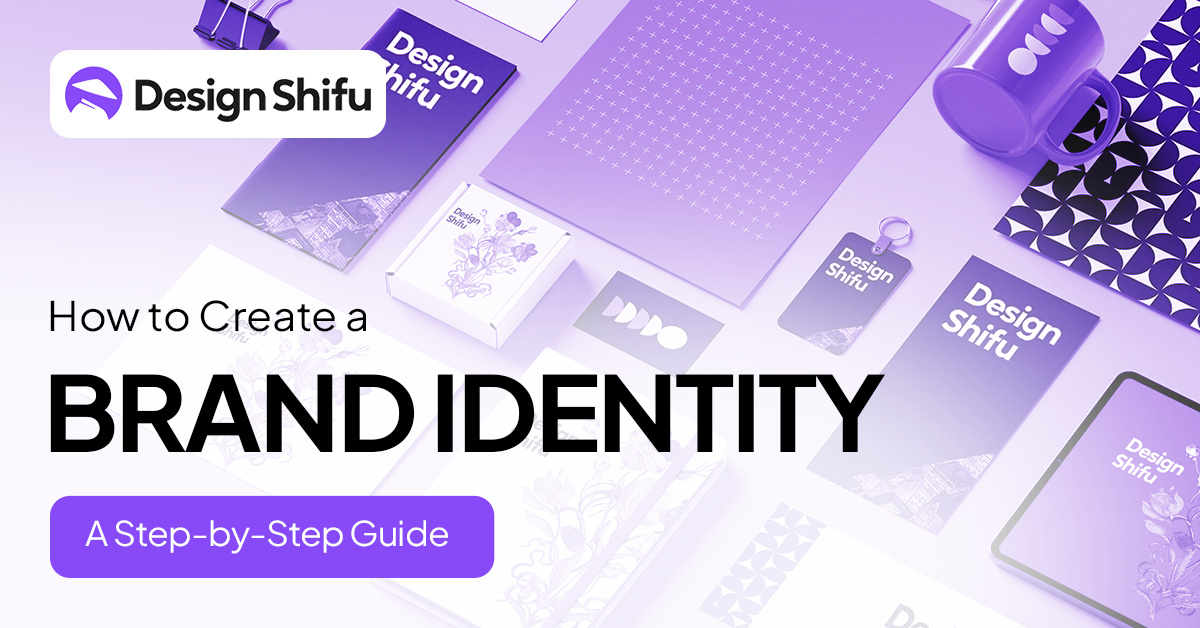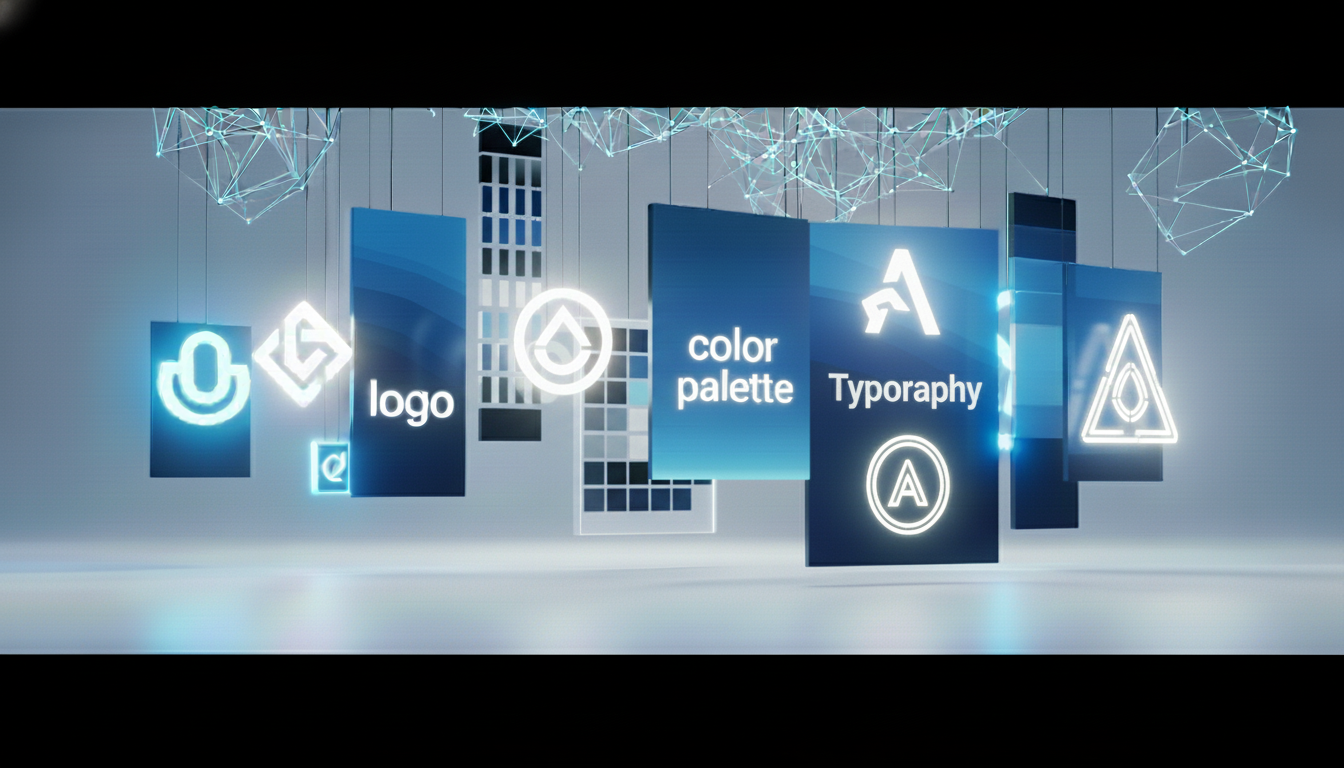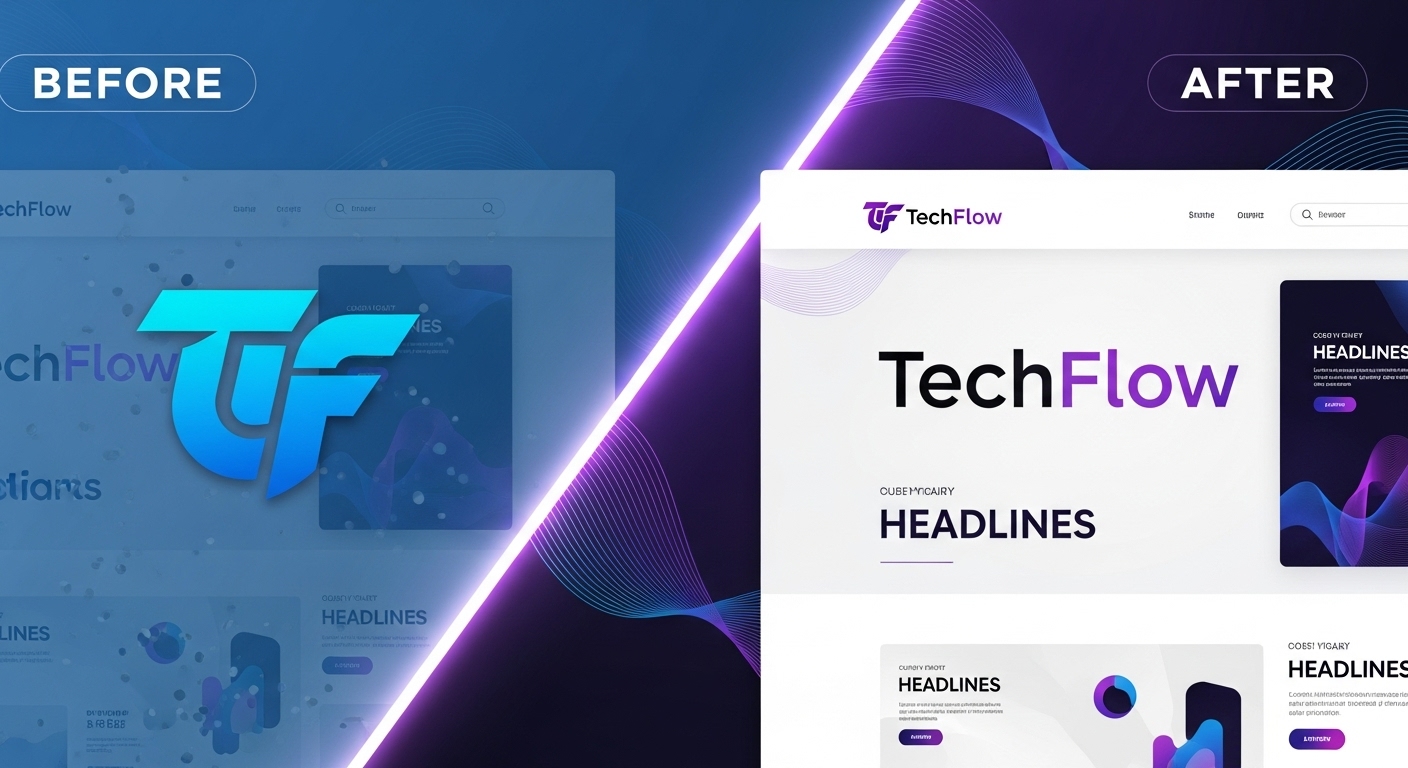Your brand is more than just a logo, it’s your business’s personality, reputation, and first impression all rolled into one. In a sea of competition, how to create a brand identity is what makes you stand out, earn trust, and turn curious browsers into loyal customers.
Whether you’re launching a startup or revamping your current look, If you want to craft a strong brand identity that appeals to your people, you’re on the right page.
This guide will walk you through building a brand that not only looks good, but feels right to the people who matter most.
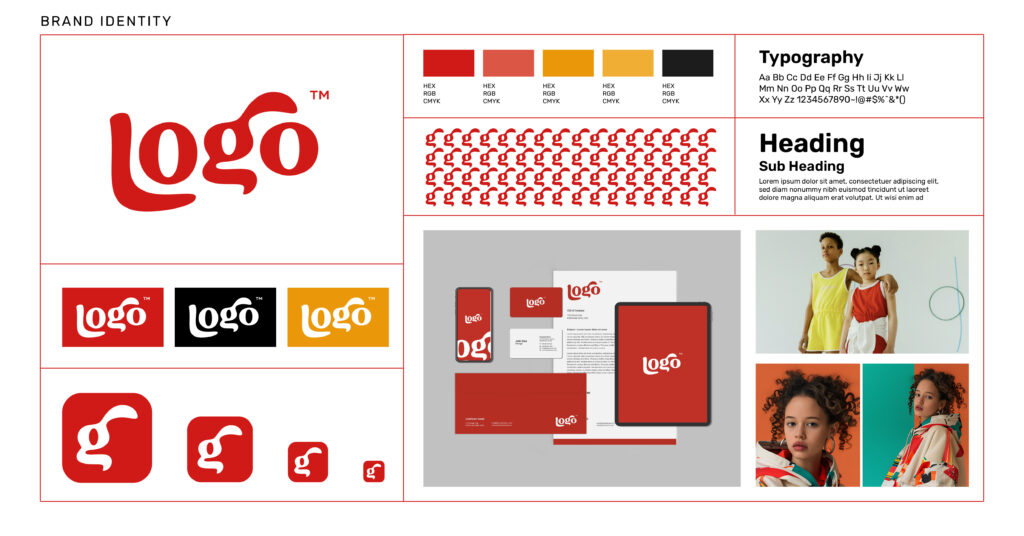
1. Understand Your Brand
Before diving into the visual elements of your brand, it’s important to understand what your brand stands for.
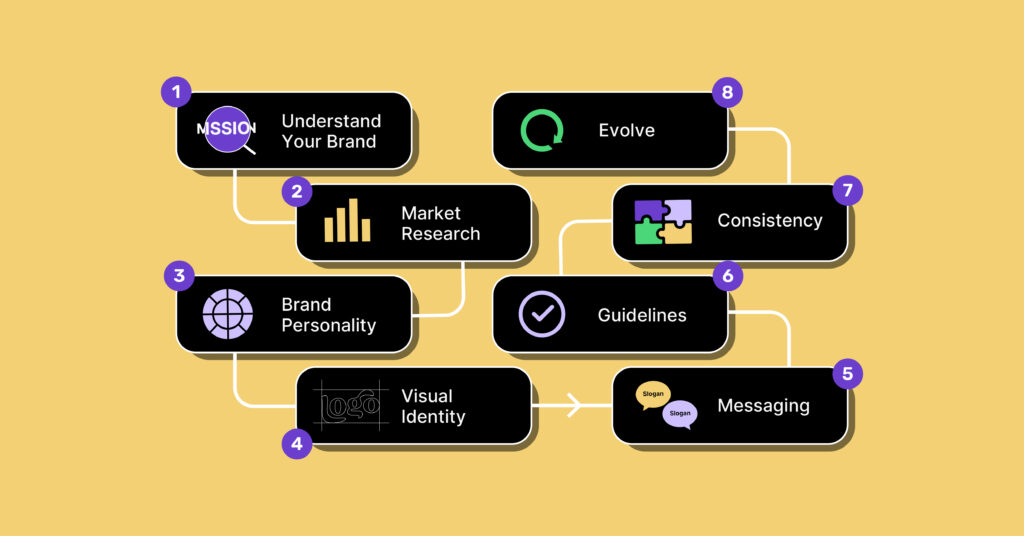
Know Your Purpose
- Your brand’s purpose and vision are the core of your identity. Your question should be: Why does your brand exist? What are you doing for your customer?
- A good brand identity is built on a clear purpose. Having a clear understanding of your “why” will have a clearer vision for how you need to position yourself in the market.
Identify Your Values
- What does your brand stand for? Your values set you apart from the competition and bring customers who adhere to similar values.
- Whether it’s sustainability, innovation, or customer focus, ensure your brand values are real and reflected across all platforms.
Know Your Target Audience
- Who are your customers, and what do they care about? Getting to know your audience is key to developing an identity that will connect with them.
- Identify their demographics, needs, desires, and pain points. When you align your brand identity with the preferences of your audience, you establish a more significant connection.
If you’re new to all this and require expert assistance in taking your brand’s purpose and turning it into design, think about hiring services such as Design Shifu, which is dedicated to turning brand ideas into creative, on-demand design
2. Conduct a Competitor and Market Analysis
Next, you need to explore your competition and the market landscape.
Study Your Competitors
- Examine what your competition is doing with their branding. What are they doing? How are they communicating with their public?
- Seeing what their strengths and weaknesses are will allow you to identify areas where you can differentiate.
Understand Market Trends
- Stay updated on industry trends and changes in customer behavior. The market keeps changing, and your brand must keep up.
- Monitor new technologies, design trends, and consumer tastes to remain relevant.
3. Define Your Brand’s Personality
Your brand should have a unique personality that is consistent with your values and resonates with your audience. Consider the type of relationship you want to establish with your customers.
Tone of Voice
- How does your brand speak? Are you formal, informal, friendly, authoritative, or funny? Your brand’s tone of voice should be an extension of your personality and the type of relationship you wish to have with your audience.
- For instance, a high-end brand may take on a more refined and formal tone, whereas a youth brand may employ a more casual, playful tone.
Brand Archetypes
- Another means of defining the personality of your brand is by employing brand archetypes. Let’s say, for example, that your brand is all about exploration and adventure.
- Your brand may then fall under the “Hero” archetype. If your brand is concerned with innovation and creativity, your brand may fit best under the “Creator” archetype.
- The archetypes guide the emotional relationship your brand builds with its consumer base.
Emotional Connection
- The aim of your brand personality is to create an emotional connection with your audience. The question to ask yourself is: How do I want my audience to feel when they engage with my brand?
- This emotional connection will drive advocacy and loyalty.
After establishing your brand archetype and tone, you can engage with Design Shifu to create uniform visuals that embody your brand personality
4. Design Your Visual Identity
Now it’s time to turn our attention to the visuals, the face of your brand.
Logo Design
- Your logo is the initial impression of your brand, and it has to be memorable and versatile. Simple, scalable, and relevant to your business, it has to show your brand’s essence and be unique and easy to recognize.
Color Palette
- Colors play a powerful psychological role in how individuals perceive your brand. Blue, for instance, invokes trust, green signifies sustainability, and red communicates passion and energy.
- Select a color scheme that fits your brand personality and elicits the correct emotional response.
Typography
- Typography is not merely selecting a pretty font. Your typefaces must be readable, unique, and consistent throughout all materials.
- Regardless of whether you select modern, serif, or sans-serif fonts, they must be representative of your brand’s tone and easy to read digitally as well as in print.
Imagery and Graphics
- Your visuals and images need to enhance and reinforce your brand identity. Depending on the use of photographs, illustrations, or icons, make sure your visual components remain in sync with your brand’s message and persona.
- Quality professional visuals contribute extensively towards building the credibility of the brand.
To professionally design your visual identity from logos to custom graphics trust Design Shifu, a design service firm with a reputation for fast turnaround and endless revisions
5. Develop Your Brand Messaging
Your brand messaging tells the world about your brand’s essence. It’s the way you share your story and relate to your audience.
Craft Your Brand Story
- Every brand has a story to tell. Whether it’s about how you got started, the challenges you overcame, or the mission that drives you, your brand story should connect on an emotional level with your audience.
- Be honest and make it relatable, this will get your customers more connected to your brand.
Tagline & Slogan
- A memorable tagline or slogan is a concise expression of your brand’s promise or mission. It should be short, catchy, and communicate your unique value.
- Think of Nike’s “Just Do It” or McDonald’s “I’m Lovin’ It” – both are instantly recognizable and reflect the brand’s identity.
Value Proposition
- A value proposition simply tells you what your brand is all about. What differentiates you from others, and why do customers have to do business with you?
- A good value proposition is the cornerstone of your messaging and informs customers of the value of your products or services.
6. Create Brand Guidelines
Brand guidelines are necessary in order to remain consistent on every touchpoint.
What are Brand Guidelines?
- Brand guidelines are the rules that inform how your brand is represented through various media. They contain the details on usage of the logo, color, fonts, image, tone, and so much more.
- Following these guidelines assures that your brand remains consistent everywhere it is put out.
Consistency Across All Platforms
- Your brand should look and feel the same everywhere – whether it’s on your website, social media, email campaigns, or packaging.
- Consistency is key to building recognition and trust with your audience.
How to Write Brand Guidelines
- When developing brand guidelines, have sections for logo specifications, color use, typography, tone of voice, and imagery.
- Make this document simple to read and available to everyone who works with your brand, including employees, designers, and marketers.
Importance of Adherence
- Adhering to your brand guidelines is important to keep your brand identity intact. Even minor variations can water down your brand’s recognition and confuse your audience.
7. Apply Your Brand Identity Consistently
Having established your brand identity, it’s time to begin putting it into practice on all levels of your business.
Internal Application
- Your employees need to be aligned with your brand’s identity. That means learning your mission, values, tone of voice, and how to speak with customers in a manner that is aligned with your brand.
- Internal training can keep everyone on the same page.
External Application
- Make sure your brand identity is applied consistently to all external materials: website, social media, ads, brochures, and packaging.
- Coherence across all touchpoints makes your brand stronger and gains the audience’s trust.
Brand Touchpoints
- Brand touchpoints are all the times customers are in contact with your brand, both in and out of the office.
- From your website and social media profiles to packaging and customer support, make your brand visible and consistent at all touchpoints.
8. Evolve and Adapt Over Time
Your brand identity isn’t set in stone, it should adapt as your company grows and the market evolves.
Why Brands Change
- As your industry and company evolve, so must your brand. Rebranding doesn’t equal throwing out your core identity, it means remaining relevant and changing to new trends and consumer demands.
Indications Your Brand Requires a Facelift
- If your brand does not feel current, your messaging is not working, or your visuals aren’t projecting your brand’s personality, it may be time to refresh.
- Minor adjustments or a full redesign can revitalize your brand.
How to Evolve Without Losing Your Essence
- When refreshing your brand, be authentic to your mission and core values. Retain the aspects that connect with your audience but update your visuals and messaging to remain current.
Conclusion
Developing a strong brand identity can be a lengthy process but is one of the best ways to build trust, recognition, and loyalty with any customer base.
You will be able to create a brand identity that resonates with customers and leaves a lasting impression by establishing your purpose, defining your brand personality, developing a suite of visuals, and following through.
If you need professional assistance along the way, Design Shifu’s unlimited graphic design services can help turn your brand visuals into reality, whether logo design, social media templates, or branded marketing materials.
Design Shifu ensures consistency across all touchpoints with a dedicated team of designers.
Are you ready to create your own brand identity? Begin with these steps and let Design Shifu’s branding design solutions make your business flourish in today’s competitive world.
Frequently Asked Questions
What is brand identity, and why is it important?
Brand identity is the visual and emotional representation of your brand, think logos, color palettes, fonts, tone of voice, and how your brand makes people feel. It’s important because it differentiates your business from competitors, builds customer trust, and creates consistency across all touchpoints.
What elements make up a strong brand identity?
A strong brand identity includes your logo, typography, brand colors, imagery style, brand voice, mission, and core values. When all of these come together in harmony, they produce a concise and recognizable impression that speaks to your target audience.
How do I define my brand’s personality?
Begin by asking: If your brand were human, how would it speak, behave, and dress? Consider your audience and how you’d like them to view your brand, professional, fun, high-end, or friendly? Apply this knowledge to develop a consistent tone of voice and visual aesthetic.
What’s the difference between a logo and brand identity?
A logo is only one aspect of your brand identity, it’s the visual sign people equate with your brand. Brand identity, however, is the entire system of visuals, messaging, and strategy that establishes your brand’s personality and influences how it’s perceived.
How can small businesses build a professional brand identity on a budget?
Use tools such as Canva or collaborate with cost-effective services like [Design Shifu](#) which provide unlimited graphic design at a fixed cost. Begin with a logo, establish your color palette and typography, and design brand templates to have uniformity on social media and marketing materials.
How long does it take to create a full brand identity?
It will vary with the level of the branding. A minimum identity involving a logo, color palette, and fonts will be between a few days to one week. A large-scale identity, including brand guides, tone of voice, and visual identities for platforms, will take weeks to craft strategically.

